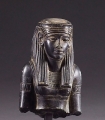Some people might find the idea of purchasing antiquities a bit intimidating. After all, prices are high, and the objects are extremely rare and often thousands of years old. However, the delight one experiences in being the custodian of such an ancient art object as it travels further along on its journey through the ages while simultaneously enjoying the object’s unique beauty should overcome the fear of getting in on this life enhancing experience.
For those who are still hesitating, the brothers Aboutaam, Ali and Hicham, have made purchasing ancient art extraordinarily user-friendly. First of all, Phoenix Ancient Art galleries, located in Geneva and New York, are open to the public and NOT by appointment only. They publish catalogues and offer curated exhibitions of their collections. The Aboutaams have recently started e-tiquities to further simplify the acquisition of ancient art through the internet.
The most impressive service that the Aboutaams offer, which should set the most nervous potential collector at ease, is their guarantee. Phoenix will stand behind their product, even if it means a full refund on a million-dollar piece whose provenance turns out to be false.
Peter Chavkin of the law firm Mintz Levin, who has worked with the Aboutaams and others in the antiquities marketplace, explains that, “the Aboutaams have the wonderful approach of not sticking collectors with a piece that turns out to have problems.”
Because of these practices business is booming at Phoenix Ancient Art, selling more antiquities at higher prices than the famous auction houses Christie’s and Sotheby’s.
So now there is no excuse not to get involved in a more active way with antiquities. Go get yourself a 4,000 year old statue. You’ll be glad you did.

